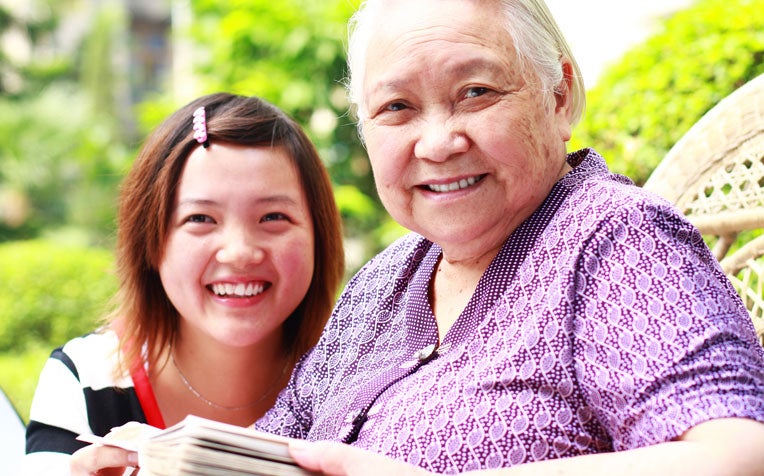
For good bone health, a healthy lifestyle with regular exercise and a diet containing adequate calcium and vitamin D is key.
Good bone health is key to preventing osteoporosis
Osteoporosis is a chronic condition where over time bone mass and strength are reduced as a result from the imbalance between bone formation and bone resorption. For the past 30 years in Singapore, the incidences of hip fracture in people aged 50 and over have increased 5 times in women and 1.5 times in men respectively. Women are at higher risk of osteoporosis, especially after menopause as they can lose up to 20% of their bone mass due to the drop of estrogen level, which usually helps to protect bones.
Adequate calcium intake can help to slow down the rate of bone loss. Calcium requirement for women 19-50 years old is 800-1000 mg/day, above 50 years old is 1000-1200 mg/day. Dairy products such as yoghurt, cheese and milk are excellent source of calcium. Soy products such as taukwa, tofu and calcium fortified soymilk are good alternatives too. Non-dairy calcium sources such as green leafy vegetables and nuts have lower bioavailability which means only minimal amount is absorbed by human body.
Vitamin D is essential for calcium absorption. The daily requirement for vitamin D is 10-15 mcg (which is equivalent to 400-600 IU). Generally, exposure to sunlight about 10-15 minutes daily would be sufficient to produce adequate vitamin D in body. Other than relying on sunlight, regular consumption of oily fish (e.g. salmon, tuna, mackerel), egg yolks, cheeses, milk and fortified soymilk help to ensure adequate Vitamin D intake.
The following is the summary of foods that are high in calcium and vitamin D:
| Food | Serving Size | Estimated Caclium (mg) | Estimated Vitamin D (mcg) |
|---|---|---|---|
| High Calcium Low Fat Milk | 1 cup (250ml) | 500 | 1.7 |
| High Calcium Soymilk | 1 cup (250ml) | 500 | 1.6 |
| High Calcium Skimmed Milk Powder | 2 heaped tbsp (30g) | 600 | 2.6 |
| Low Fat Cheese | 1 slice | 240 | 0.8 |
| Calcium Fortified Milk Bread | 2 slices | 200 | 0.7 |
| Calcium Fortified Orange Juice | 1 cup | 360 | 2.5 |
| Taukwa | 1 small cake (90g) | 150 | n/a |
| Spinach (cooked) | 1 cup | 140 | n/a |
| Almonds | 1 cup | 380 | n/a |
It is never too late to take steps to slow down natural bone loss and prevent brittle, weak bones, but one should start healthy habits early on, with regular exercise and a diet containing adequate calcium and vitamin D.
From childhood to old age, there are different things to take note of.
From birth to nine: Good diet is key
Babies and young children need calcium for strong bones and teeth. Healthy babies do not need supplements, except for vitamin D, which is vital for calcium absorption, said Dr Han Wee Meng, Head and Senior Principal Dietitian, Department of Nutrition and Dietetics, KK Women’s and Children’s Hospital (KKH), a member of the SingHealth group. Vitamin D deficiency may lead to rickets, which can cause soft and weak bones.
Vitamin D is found in breast milk and infant formula, but not in sufficient amounts. The United States Centers for Disease Control and Prevention (CDC) recommends that all breastfed babies be supplemented with 400 iU (10 mcg) of vitamin D daily. Requirements increase as a child grows. The daIly recommended dietary allowance (RDA) for calcIum Is 400mg for Infants, 500mg for ages one to three, 600mg for ages four to six, and 700mg for ages seven to nine.
Calcium-rich foods include milk, calcium-fortified soya milk, cheese, dried figs, bean curd, and yogurt. Margarine, fortified milk and oily fish, such as sardines or mackerel, are rich in Vitamin D. Another potential source of vitamin D is its synthesis in the skin from exposure to sunlight for 10 to 15 minutes a day.
During puberty years: Build up bone mass
Bone mass acquired while young determines skeletal health for life. Puberty is a crucial time for the developing skeleton. The critical bone-building years are between the ages of 10 to 18. For girls, having regular periods is important for bone health, as it indicates sufficient production of oestrogen, which improves calcium absorption in the kidneys and intestines.
Eat sufficient calcium-rich foods such as dairy products and calcium-fortified foods like cereals and soya milk, and do weight-bearing exercises regularly. These allow gravity to exert on the body, which is vital for reaching maximum bone strength.
Ref: L20
Contributed by


















 Get it on Google Play
Get it on Google Play